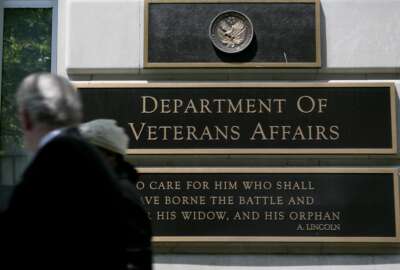

The Department of Veterans Affairs is on track to exceed its hiring goals for its health care workforce fiscal 2023, but is also speeding up the time it takes t...
The Department of Veterans Affairs is on track to exceed its hiring goals for its health care workforce fiscal 2023, but is also speeding up the time it takes to fill vacant positions.
February marks the first month so far this fiscal year that the Veterans Health Administration reduced its time-to-hire.
Undersecretary for Health Shereef Elnahal told reporters Monday that VHA is looking to further reduce the time-to-hire through “proactive recruitment,” and eliminating the time it takes the VA’s human resources office to post a vacant position on USAJobs.
Elnahal said it can currently take VHA up to two months to advertise a job from the time the position’s been vacant.
“If we have an automatic way that vacancies are posted and ultimately triggered for recruitment, we can eliminate that inefficient period of time,” Elnahal said. “That’s one major way we’re reducing time-to-fill.”
Meanwhile, the VHA is setting a record pace for hiring and significantly reducing turnover within its health care workforce.
VHA’s total workforce grew by 9,590 employees in the first five months of FY 2023 — a 2.5% increase. That’s the agency’s highest growth rate in more than 20 years. The agency expects to meet its year-end goal to grow its workforce by at least 3%.
VHA has made 22,759 total external hires so far in fiscal 2023 — about 44% of its 52,000 hiring goal for the year.
“We’re likely, very likely to exceed that 52,000 goal,” Elnahal said.
The agency is seeing nationwide progress on its hiring goal, with 16 out of the 18 Veterans Integrated Services Networks (VISNs) meeting their hiring goals.
Elnahal said the VHA has also nearly cut its rate of attrition in half, compared to last year.
The agency saw a loss rate of 2.1% this January, down from 4% in January 2022. He said increased hiring combined with a lower rate of attrition, is helping to reduce burnout among VA clinicians.
“As we staff up, that is inherently something that benefits folks, in terms of a better distribution of workload,” Elnahal said. “I hope that is a phenomenon that accelerates, not recedes, as we continue to get more and more folks on board.”
VHA’s robust hiring efforts are meant to help the agency handle an increased workload under the PACT Act, which expands eligibility for VA health care and benefits to veterans exposed to toxic burn pits during their military service.
The VHA, so far this fiscal year, has seen an increase of 27,000 new health care enrollees above its baseline for last year.
Elnahal said the agency expects much of that increase accounts for the “likely impact from the PACT Act,” although the agency expects to have more accurate metrics for how many veterans the PACT Act has brought into VA care, as the agency updates its health care eligibility enrollment system.
VHA has conducted 2.8 million toxic exposure screenings in the fiscal year so far, and is “well ahead of schedule” of screening 4.5 million veterans end of the fiscal year.
About 42% of veterans who have gone through the screenings told clinicians they think they may have been exposed to toxic burn pits during their military service.
“That number is certainly higher than what I expected,” Elnahal said.”What that will mean is a significant number of veterans benefiting from the legislation, which is a good thing. It puts the onus on the health care system to make sure the capacity is there, which is why we’re focused on hiring.”
VHA is also standardizing position descriptions for health care workers, and moving ahead on an initiative that began last year to standardize how many patients VA providers are expected to see during each clinic season.
“Right now, we are for the first time as a health care system, holding every provider accountable for certain thresholds and expectations for clinical productivity,” Elnahal said, adding that the agency is aiming for 80% of its clinics to meet its productivity standard.
“That is the most important way that access to the direct care system within VA can be improved. This is a best practice that is commonplace in the private sector,” he added.
The VHA also sees opportunities for efficiencies in patient scheduling. The agency, this as soon as the summer, will launch a pilot of its Internal Scheduling System (ISS).
The system, developed internally by VA’s Office of Information and Technology, is focused on helping medical support assistants see all of the appointment availability for a particular VA provider.
“Right now, we don’t have a system that allows for that. Often our medical support assistants, and I’ve seen this workflow myself … we have to bring in multiple windows — five, six, seven windows — to be able to navigate what the soonest appointment is, and it’s just that much harder operationally to get the job done for veterans with our current system,” Elnahal said.
VHA is also looking for a commercial off-the-shelf system to manage referrals to community care.
The VA expects to release a request for proposals later this spring for a commercial off-the-shelf scheduling solution that will support scheduling for non-VA community care.
Elnahal said the VHA is seeking a separate schedule system for community care referrals so the agency can “see directly into the scheduling grids” of some of its highest-volume community providers. He said the agency is looking for a commercial solution that functions like ZocDoc or Kyruus.
Elnahal said managing these scheduling challenges means VHA’s community care offices are only able to schedule about seven-to-nine patients a day for non-VA appointments.
“We think the community care scheduling challenge is mostly around the coordination of care with different health systems, and the complexities of getting someone on the phone at the right clinic for the right specialty. Coordinating back with the veterans on whether they’re available against those slots, that ends up being so much work for our community care offices,” he said.
The VHA is piloting a commercial solution in Columbia, South Carolina in an effort to significantly increase the number of community care referrals.
The VA is also working on a final “deployment decision” on whether it will proceed with its new Electronic Health Record going live in Saginaw, Michigan this June, as planned.
The Saginaw VA medical center is scheduled to be the first new go-live of the multibillion-dollar Oracle-Cerner EHR since the VA paused rollouts last October.
“We’re deliberating right now as a team, as an agency about our readiness to do that against the criteria that Saginaw would need to meet,” Elnahal said, adding that the agency is “shooting to the best of our ability” to keep the EHR go-live on schedule.
Meanwhile, the VHA finalizing new “readiness criteria” for all future EHR go-lives, based in part on findings from its EHR modernization sprint team report.
The VA expects to submit an updated schedule to Congress this May giving lawmakers a broader look at its implementation plans.
The Government Accountability Office recently found that in surveys from 2021 and 2022, only 6% of VA users of the Oracle-Cerner EHR agreed the system enabled quality care. About 4% of respondents agreed that the new system made them as efficient as possible.
Elnahal said the VA’s Veterans Experience Office is working on new ways to survey users of the new EHR.
“I do not think our employees are resistant to change. I think change is challenging, and that’s the case in any setting where you’re trying to introduce a new system. But I believe VA employees have demonstrated time and again, that they can adopt new technologies, they can adopt change, especially when that change is needed to improve care for veterans,” Elnahal said.
Copyright © 2024 Federal News Network. All rights reserved. This website is not intended for users located within the European Economic Area.
Jory Heckman is a reporter at Federal News Network covering U.S. Postal Service, IRS, big data and technology issues.
Follow @jheckmanWFED



